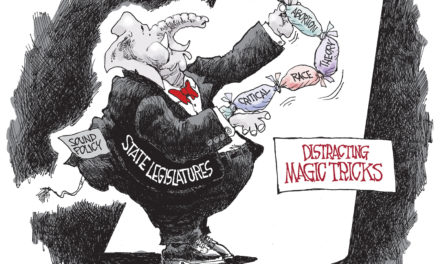We’ve promised to swear off – if not viscerally reject – any comparisons of Memphis to Detroit, but a recent post in Detroit caught our eye because it offered some warning signs for where its planning went off the rails.
As we’ve said before, Memphis is not at risk to become the next Detroit. Such derogatory comparisons, regular staples of the comments section of the news media, ignore the vast difference between the key indicators of the Motor City and Memphis. In addition, Memphis has more assets than Detroit and they give us a reasonable chance to improve our relative position – but only if we get our act together.
Memphis has no margin for error, so it’s instructive to hear the answers from Detroit urban planner Pete Saunders to what exactly did Detroit get wrong and why did it collapse? More to the point, what are warning signs that we should be alert for?
1 – Poor neighborhood identification. Detroit has poorly defined neighborhoods and it contributed to lack of cohesion to tackle issues in a neighborhood context, which in turn undermined community ownership. Memphis has an array of maps that purportedly show Memphis’ distinct neighborhoods, but often they seem designed more to put a context on public and private programs than to accurately map actual neighborhood boundaries. In addition, we need a program similar to other cities that designate neighborhoods with banners and signs paying tribute to their unique characteristics as ways to build neighborhood cohesion.
2 – Poor housing stock. All of us have seen those photographs of bombed out neighborhoods of Detroit that resemble European cities after World War II. Detroit has a huge number of abandoned ruins but it also has “more homes that simply don’t generate the demand that higher quality housing would,” and that’s a major contributor to the extremely cheap housing.
3 – A poor public realm. Detroit’s streetscape is unbelievably bad, underscoring the importance in redevelopments like Overton Square getting their streetscapes right. Detroit is made boring by the lack of signs, landscaping, street trees, underground wiring, and banners, and primary corridors are pedestrian unfriendly. Memphis’ public realm is better but we hardly deserve bragging rights, but little by little, design issues are gaining the importance here they deserve.
4 – Downtown was allowed to become weak. For most of the last century, Detroit’s downtown was strong and successful, but it was allowed to become a weak secondary market which could not compete with the suburbs. Our downtown is going through a painful time, but the good news is that the widespread understanding about its importance has moved its success to the front burner of civic priorities.
5 – Freeway expansion. Detroit is covered with freeways which undermined the strength of its urban core. Think I-269 bleeding economic life from the urban center and the 2040 Long-Range Transportation Plan for Memphis, which creates 1,000 more miles of asphalt that feed, encourage, and subsidize an auto-centric lifestyle that is financial insanity.
6 – Lack of/loss of a transit network. Lobbying by car manufacturers to eliminate Detroit’s extensive streetcar network in favor of buses was successful on the premise that buses offered more flexibility. Unfortunately, there was no history of commuter rail or alternative transit options and this accelerated Detroit’s decline to a point it could not pull up. The ineffectiveness of Memphis’ buses, the lack of trolleys as a real transportation option, and the poor bus experience here are trouble signs demanding attention once and for all.
7 – Local government organization. Changes that resulted from early 20th century’s Progressive Era led to the abandonment of a City Council elected by districts in favor of citywide elections. It changes back next year with elections by Council districts but a century of citywide elections created a distance between government and the people it serves and neighborhoods lacked champions in the public halls of power.
8 – An industrial landscape that constrained the city’s core. Detroit had a unique land use pattern in which industrial uses were not concentrated in districts but spread throughout the city. Memphis’ land use patterns haven’t always been particularly wise or rational but compared to Detroit, we’re in much better shape.
9 – Ill-timed and unfulfilled annexation policy. Detroit overannexed and created a push for suburbanization in a city that had previously featured high densities. The emphasis on annexation also resulted in low-quality housing with little contemporary appeal.
Each of us could draw up our own list of decisions that contributed to Memphis’ challenges today, notably the hellbent fueling of sprawl and the historic relocation of Memphians under the guise of “growth”; the “annexation at any cost” attitude based on incomplete cost/benefit analyses; the abuse of Planned Developments (PDs) that gave developers carte blanche to disrupt land use patterns and neighborhoods cohesion; the obsession with low-wage, low-income jobs as the basis for economic growth and an overall absence of resilient economic development strategies; and lack of attention to high quality urban design.
Things are changing and they must pick up speed, because it’s never been clearer that 30 years of poor public policy created unsustainable development patterns – economically and environmentally. And as we have said often, we have to shed old myths, particularly the ones that any job is a good job, that any road is a good road, and that any development is a good development.
We’ve traded on those myths for far too long because of our low self-esteem and self-worth. We’ve seen what they got us, and the most encouraging fact is that things are changing. That said, we need to super charge them because one thing is undebatable: Memphis is worth fighting for.





Major Difference.
It snows more in Detroit.
The #9 warning sign re: “overannexed” is misleading. Detroit stopped annexing surrounding territory in 1926 when the sate legislature stopped giving permission and passed a state law requiring that a public referendum pass in both Detroit and in territory to be annexed, which effectively shut down Detroit’s expansion.
Between 1915 and 1925 Detroit tripled in size to its present day 139 square miles. This rapid expansion, led by real estate developers, did push Detroit to its debt limit, but the current problems in Detroit are not from over annexing. In fact the problems are due in part to the lack of annexation since the 1920s.
But annexation is not the issue. Real estate development outside of Detroit that pulled population from its core is the problem, just like Memphis. Unlike Detroit, Memphians who settled beyond the City limits are annexed to help pay for their abandonment of the City.
His history is the same as yours about annexation.
Here’s Saunders’ take on #9:
9. Ill-timed and unfulfilled annexation policy. The two maps above show (in green) the city’s boundaries as of 1915. Bear in mind that Detroit’s population exploded from 205,000 in 1890 to almost 1 million by 1920, but not much new territory was added to the city during that time. In fact, between 1892 and 1905, the city did not annex any new land, all while rapid growth was happening. With the DTR now wrapped around the city with a wall of industrial land, city leaders began looking for new lands to annex to support the expanding population.
Huge annexations began occurring in the late 1910’s but accelerated during the ‘20s. This is purely my own speculation here, but my guess is that Detroit city leaders wanted to annex areas beyond the DTR arc to establish new neighborhoods for residents working in those very factories. That, I’m sure, was the plan.
Then the Great Depression and World War II hit.
Suddenly all the farmland that was supposed to be developed into new Detroit neighborhoods in the ‘30s and ‘40s was deferred by as much as twenty years. No new neighborhoods meant that the city core that existed in 1915 was essentially the same core that existed in 1945. Sure, a very strong demand for housing developed during that 30-year period, but tensions – race, management vs. union, among others – likely grew at an even faster pace.
The industrial wall and annexation policy had four impacts on Detroit. First, it created the push for suburbanization in Detroit, as residents sought to move away from the noisy, smelly and smoky factories that dotted the landscape. Secondly, the pressure to rapidly meet the pent-up housing demand in the ‘40s and ‘50s led to the vast spread of homes that today lack contemporary appeal. Thirdly, once industrial decline occurred it contributed mightily to the blight of the city as factories became abandoned – that’s largely how the city got its famed “ruins”. A pattern was established – industrial abandonment begat adjacent residential abandonment, which begat commercial abandonment, and begat even more residential abandonment. I would argue that the vast majority of vacant, “return-to-prairie” lands in Detroit are within a two-mile radius of the DTR. And lastly, the sheer amount of industrial land, with all associated cleanup concerns, made the decommission and consolidation of industrial land for other uses extremely difficult. Not that Detroit demonstrated the will to do so. There likely was a period during the ‘70s and ‘80s when the city could have effectively redeveloped industrial land to other uses, but again Detroit doubled down on the prospect of industrial jobs.
There’s an old saying that when you have a hammer, every problem is a nail. Granted, I am a planner, and I see planning problems as key to Detroit’s demise. While this point of view hasn’t been clearly articulated before, it’s clear that given this planning and land use legacy, it’s readily apparent how Detroit got to where it is today. Detroit’s problems began precisely with the rise of the auto industry during the 1900s and 1910s, not from the beginnings of its decline 50 years later or from ill-fated attempts to resuscitate it since. The seeds of Detroit’s decline had been sown long before suburbanization accelerated in the ‘50s, or racial tensions exploded in the ‘60s.
Detroit circa 1890 was a moderately-sized Great Lakes port whose economy revolved around shipbuilding and carriage-building. It was eerily similar in size, scale and character to Milwaukee at that time. But the work of Henry Ford, William C. Durant and the Dodge brothers altered that forever.
The rise of the automobile enriched the corporations and created the template for the expansion of the middle class around the country, but it transformed the city, to its astounding detriment. Left untreated, any improvement in Detroit’s economic, social or political fortunes would still leave the city with a troubled planning legacy.
and what is memphis’ “planning legacy”? (sic)
Anon 9:27-
Memphis has a rich legacy when it comes to planning dating as far back as Kessler’s Parkway system (1901) and Bartholomew’s comprehensive city plan (1924). All but a few, minute aspects of the Kessler plan were implemented. The city was less aggressive in implementing the Bartholomew plan. In the 1960’s a comprehensive plan was put forth that- among other things- recommended a rail based mass transit system to connect existing and emerging activity centers along the Poplar corridor from downtown east to the Poplar/I-240 interchange. Implementation of that plan was very limited. Historically, the problem has not been with the planning efforts or plans themselves (except for the MPO’s laughable adherence to public feedback in its latest effort) but instead has fallen at the feet of the city and county in their failure to follow well informed principles, guidelines and design solutions.